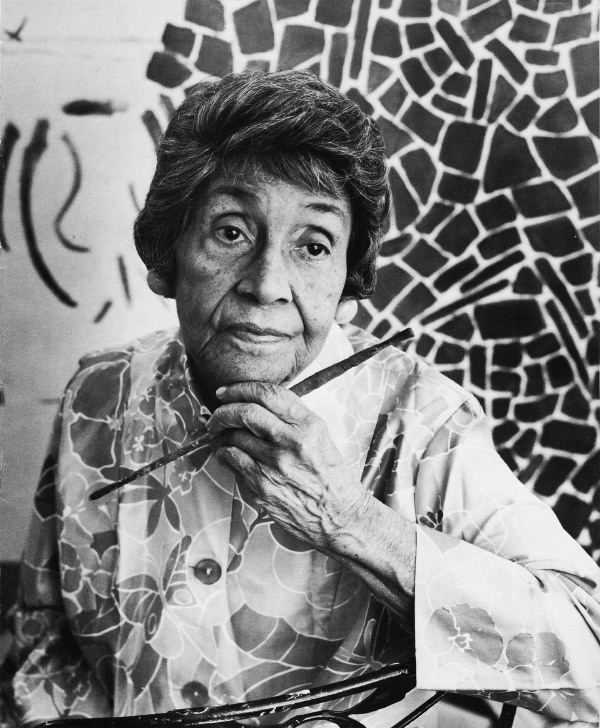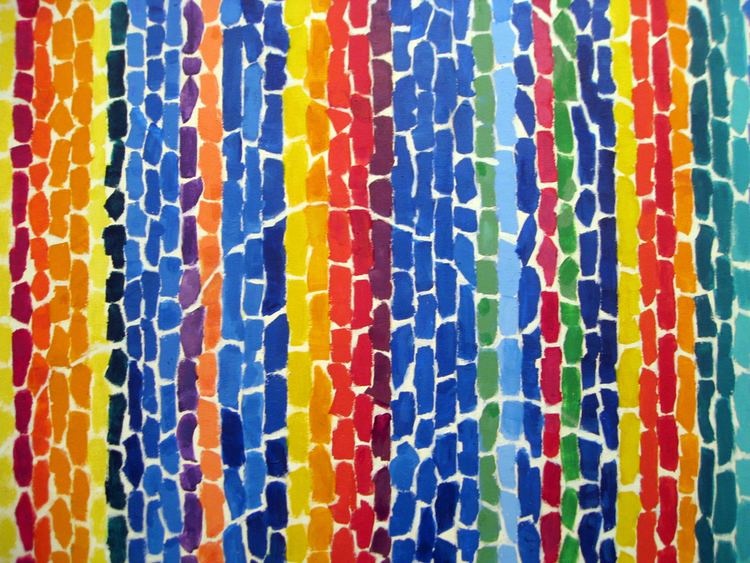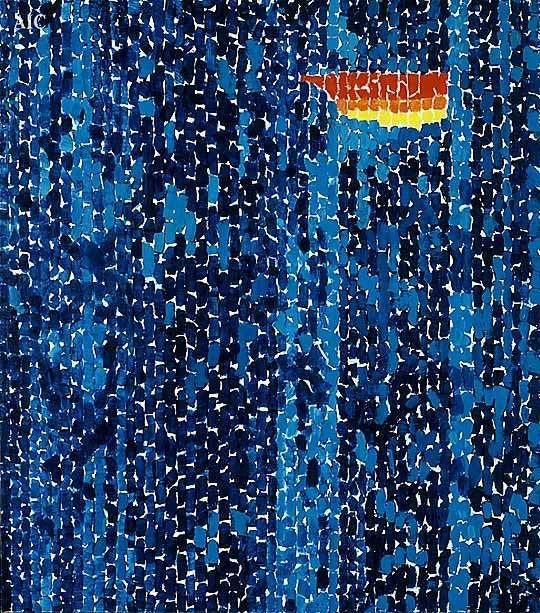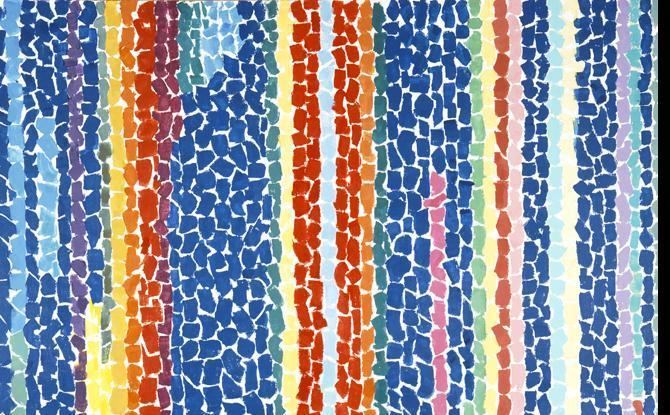Known for Painting Movement ExpressionismRealism | Name Alma Thomas | |
 | ||
Full Name Alma Woodsey Thomas Notable work Sky Light; Iris, Tulips, Jonquils and Crocuses; Watusi (Hard Edge); Wind and Crepe Myrtle Concerto; Air View of a Spring Nursery; Milky Way; Flowers at Jefferson Memorial; Untitled (Music Series); Red Rose Sonata; Breeze Rustling Through Fall Flowers; The Eclipse Died February 24, 1978, Washington, D.C., United States Artwork Watusi (Hard Edge), Iris, Tulips, Jonquils and Crocuses Education Similar Norman Lewis (artist), Lois Mailou Jones, Sam Gilliam | ||
Alma thomas alone
Alma Woodsey Thomas (September 22, 1891 – February 24, 1978) was an African-American Expressionist painter and art educator. She lived and worked primarily in Washington, D.C. and the Washington Post described her as a force in the Washington Color School. The Wall Street Journal describes her as a previously "underappreciated artist" who is more recently recognized for her "exuberant" works, noteworthy for their pattern, rhythm and color.
Contents
- Alma thomas alone
- Alma thomas
- Personal life and education
- Artistic career
- Legacy
- Notable exhibitions
- Notable collections
- References

Alma thomas
Personal life and education

Alma Thomas was born the eldest of four children to John Harris Thomas, a businessman, and Amelia Cantey Thomas, a dress designer, in Columbus, Georgia, 1891. In 1907 the family moved to the Logan Circle neighborhood of Washington, D.C., relocating due to racial violence in Georgia and the public school system of Washington. As a child, she displayed artistic interest, making puppets and sculptures at home. Thomas attended Armstrong Technical High School, where she took her first art classes. After graduating from high school in 1911, she studied kindergarten education at Miner Normal School until 1913. She served as a substitute teacher in Washington until 1914 when she obtained a permanent teaching position on the Eastern Shore of Maryland. Two years later, in 1916, she started teaching kindergarten at the Thomas Garrett Settlement House in Wilmington, Delaware, staying there until 1923.

Thomas entered Howard University in 1921, as a home economics student, only to switch to fine art after studying under art department founder James V. Herring. She earned her BS in Fine Arts in 1924 from Howard University; becoming the first graduate from the university Fine Arts program. That year, Thomas began teaching at Shaw Junior High School, where she taught until her retirement in 1960. She taught alongside Malkia Roberts. While at Shaw Junior High, she started a community arts program that encouraged student appreciation of fine art. The program supported marionette performances and the distribution of student designed holiday cards which were given to soldiers at the Tuskegee Veterans Administration Medical Center. In 1934, she earned her Masters in Art Education from Columbia University and studied painting at American University under Jacob Kainen from 1950 to 1960. In 1958, she visited art centers in Western Europe on behalf of the Tler School of Art. She retired in 1960 from teaching and dedicated herself to painting. In 1963, she walked in the March on Washington with her friend Lillian Evans.

Alma Thomas died on February 28, 1978 still living in the same house that her family moved into upon their arrival in Washington in 1906.
Artistic career
"Creative art is for all time and is therefore independent of time. It is of all ages, of every land, and if by this we mean the creative spirit in man which produces a picture or a statue is common to the whole civilized world, independent of age, race and nationality; the statement may stand unchallenged."
-Alma Thomas, 1970
Alma Thomas' early work was representational in manner. Upon further education at Howard and training under James V. Herring and Lois Mailou Jones her work became more abstract. Thomas would not be recognized as a professional artist until her retirement from teaching in 1960, when she enrolled in classes at American University. There she learned about the Color Field movement and theory from Ben L. Summerford and Jacob Kainen. She then became interested in the use of color and composition. Within twelve years after her first class at American, she began creating Color Field paintings, inspired by the work of the New York School and Abstract Expressionism. She worked out of the kitchen in her house, creating works like Watusi (Hard Edge) (1963), a manipulation of the Matisse cutout The Snail, in which Thomas shifted shapes around and changed the colors that Matisse used, and named it after a Chubby Checker song.
Her first retrospective exhibit was in 1966 at the Gallery of Art at Howard University, curated by art historian James A. Porter. For this exhibition, she created Earth Paintings, a series of nature inspired abstract works, including Wind and Crepe Myrtle Concerto (1973) which art historian Sharon Patton considers "one of the most Minimalist Color-Field paintings ever produced by an African-American artist." These paintings have been compared to Byzantine mosaics and the pointillist paintings of Georges-Pierre Seurat. A friend of Delilah Pierce, Thomas and Pierce would drive into the countryside where Thomas would seek inspiration, pulling ideas from the effects of light and atmosphere on rural environments. Thomas was, in 1972, the first African-American woman to have a solo exhibition at the Whitney Museum of American Art, and within the same year an exhibition was also held at the Corcoran Gallery of Art.
Legacy
In 2009, two paintings, including Watusi (Hard Edge), by Alma Thomas were chosen by First Lady Michelle Obama, White House interior designer Michael Smith and White House curator William Allman to be exhibited during the Obama presidency. Watusi (Hard Edge) was eventually removed from the White House due to concerns with the piece fitting into the space in Michelle Obama's East Wing office. Sky Light, on loan from the Hirshhorn Museum and Sculpture Garden, hung in the Obama family private quarters. In 2015, the Obamas hung Thomas's work Resurrection in the Old Family Dining Room. The painting is the first work by an African-American woman to hang in the public spaces of the White House as part of the permanent collection. The choice of Thomas for the White House collection was described as an ideal symbol for the Obama administration by New York Times art critic Holland Cotter. Cotter described Thomas' work as "forward-looking without being radical; post-racial but also race-conscious." Thomas' papers were donated in several periods between 1979 and 2004 to the Archives of American Art by J. Maurice Thomas, Alma Thomas' sister.
